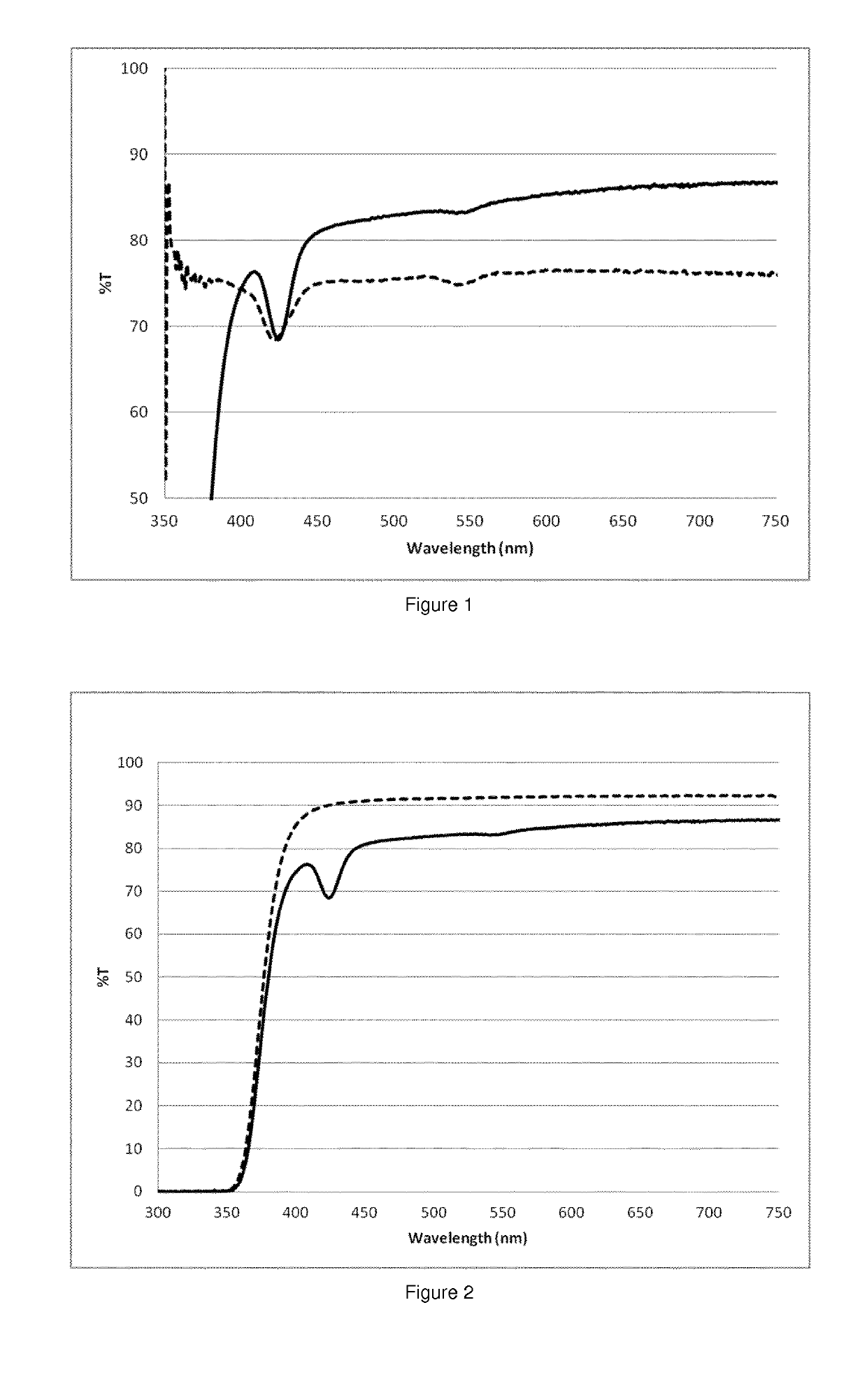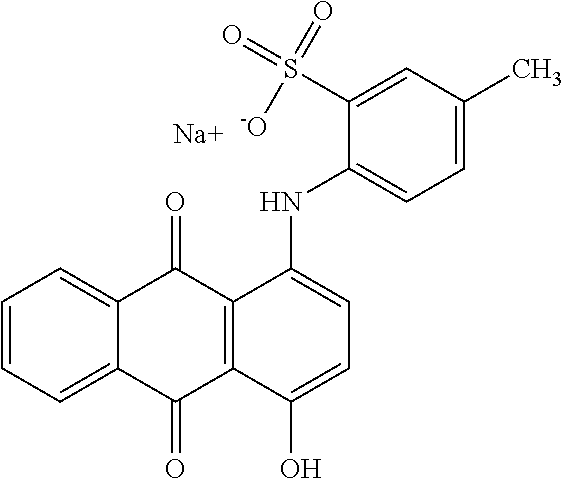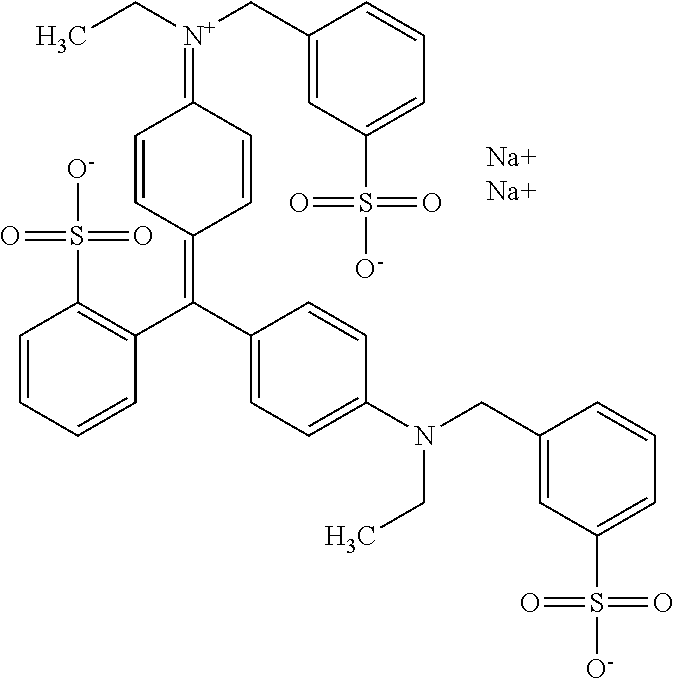Composition for the Manufacture of an Ophthalmic Lens Comprising an Encapsulated Light-Absorbing Additive
- Summary
- Abstract
- Description
- Claims
- Application Information
AI Technical Summary
Benefits of technology
Problems solved by technology
Method used
Image
Examples
example 1
on of Polymer-Based Nanoparticles Containing a Light-Absorbing Additive by Miniemulsion Polymerization
[0126]A monomer blend (5 g) is prepared from methyl methacrylate and ethylene glycol dimethacrylate in a weight ratio of 50:50, and OMNISTAB™ 47 (10 mg, available from Deltachem Co. Ltd.) is dissolved in this monomer blend. This blend is added dropwise to 50 ml of an aqueous solution containing SDS (0.5 g) and AIVN (0.05 g) at 80° C. under a nitrogen atmosphere. After completion of the monomer blend addition, the mixture is then further mixed for additional 2 h at 80° C., then centrifuged, washed with ethanol, and dried. The nanoparticles have a size in the range of 200 nm to 1000 nm and a refractive index of 1.5.
[0127]The nanoparticles are dispersed in CR39® (12.5 weight % nanoparticles in monomer) to prepare a masterbatch (Master 1).
example 2
on of Mineral-Based Nanoparticles Containing a Light-Absorbing Additive by Reverse Microemulsion
[0128]Ex. 2a: A mixture of cyclohexane (7.5 ml), n-hexanol (1.8 ml), Triton X-100 (1.5 g), OMNISTAB™ 47 (40 mg, available from Deltachem Co; Ltd), TEOS (0.1 ml) and ammonium hydroxide 30% (0.06 ml) are mixed for 24 h. Then, acetone is added and the particles are collected by centrifugation, washed with ethanol and dried. The nanoparticles have a monodisperse size centered on 100 nm and a refractive index corresponding to precipitated silica, around 1.47.
[0129]The nanoparticles are dispersed in CR-39 (12.5 weight % nanoparticles in monomer) to prepare a masterbatch (Master 2a).
[0130]Ex. 2b: 7.56 g of Triton X-100, 5.86 g hexan-1-ol, 23.46 g cyclohexane, 1.6 ml deionized water, 0.32 ml of methylene blue solution (CAS: 61-73-4, 1% weight solution in water) which is the light-absorbing additive, 0.4 ml of TEOS, and 0.24 ml of 30% ammonium hydroxide solution in water are mixed and stirred at r...
example 3
on of Mineral-Based Nanoparticles Containing a Light-Absorbing Additive by Stober Process
[0141]384 mL of methanol is added in 1000 ml bottle. Then, 96 ml of NH4OH (30% weight solution in water) and 6.4 mL of methylene blue (CAS: 61-73-4, 2% weight solution in deionized water) are added. The mixture is stirred (magnetic stirring) at 400 rpm for 10 min. After that, 3.2 ml of TEOS is added dropwise and stirred at 800 rpm for 2 h.
[0142]After reaction is complete, particle size is checked by Dynamic Light Scattering. The average particle size is around 200-230 nm (mono-disperse).
[0143]Mixture is transferred to round bottle flask for evaporating 1 h in order to reduce the volume of methanol from 500 to 100 ml, then, centrifuged at 4000 rpm for 45 min. Supernatant is removed and nanoparticles are retrieved as concentrated dispersion in methanol.
[0144]Mixture is then cleaned two times with the following procedure: 50 ml of methanol is added with sonication to re-disperse particle. Nanoparti...
PUM
| Property | Measurement | Unit |
|---|---|---|
| Size | aaaaa | aaaaa |
| Size | aaaaa | aaaaa |
| Weight | aaaaa | aaaaa |
Abstract
Description
Claims
Application Information
 Login to View More
Login to View More - R&D
- Intellectual Property
- Life Sciences
- Materials
- Tech Scout
- Unparalleled Data Quality
- Higher Quality Content
- 60% Fewer Hallucinations
Browse by: Latest US Patents, China's latest patents, Technical Efficacy Thesaurus, Application Domain, Technology Topic, Popular Technical Reports.
© 2025 PatSnap. All rights reserved.Legal|Privacy policy|Modern Slavery Act Transparency Statement|Sitemap|About US| Contact US: help@patsnap.com



